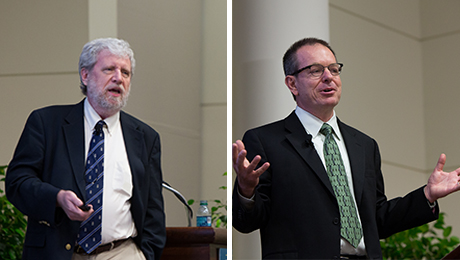Nearly 200 faculty members at the George Washington University took on the role of students for Teaching Day, a workshop sponsored by the GW Teaching and Learning Collaborative that brings nationally recognized speakers to present on issues facing higher education faculty.
The seminar, held in the Marvin Center on Friday, featured Conradi Eminent Scholar and Professor of Psychology at Florida State University K. Anders Ericsson, who presented research methods on building expertise in students, and Morgan Distinguished Professor of Educational Innovation at University of North Carolina at Chapel Hill Keith Sawyer, who examined ways to make creativity central to the classroom learning process.
Teaching Day began three years ago as an initiative of the TLC, an initiative of the Office of Teaching and Learning within the Office of the Provost, geared toward serving faculty and staff to support the quality of instruction at the university.
“Great teaching is fundamentally about inquiry and the students' exploration of a new intellectual world,” said Vice Provost for Teaching and Learning Steve Ehrmann. “It is also about the faculty members experimenting with ways to engage and guide the students. Our Teaching Day speakers share useful insights from the frontiers of educational research into more efficient, effective ways to help university students learn.”
TLC Director and Associate Provost Denis F. Cioffi introduced Provost Steven Lerman, who kicked off the event with a welcome address that challenged the faculty to use Teaching Day as an opportunity to think critically about how to respond to the shifting landscape of the higher education system and better serve students in preparing for the post-graduate workforce.
“There is a challenge for us,” Dr. Lerman said. “How do we take what we know about changes in how students learn, and how do we use the insights we are beginning to get from the sciences and other disciplines and translate those ideas into concrete changes in how we teach our students?”
“I believe there is a positive path forward toward a modern, experience-based undergraduate education, but only if we are able to take in new perspectives and change,” he said.
Following the opening remarks, Dr. Ericsson, author of the “Cambridge Handbook of Expertise and Expert Performance” and contributor to the best-selling book “Outliers” by author and journalist Malcolm Gladwell, presented a lecture on deliberate practices used to create experts.
Echoing the sentiments of Dr. Lerman, he noted that while lecturing is often used in college classrooms, it proves ineffective because the process of learning does not mimic the practical application.
He used the example of a figure skater who wants to perform a double 360-degree turn. To perform a “double,” figure skaters must gradually stay up longer in the air, simulate the move and change other movements until they are able to achieve it.
“We now know all of the individual steps that people complete to make this transition,” he said. “It shows that there isn’t automatic experience doing anything, it’s pushing yourself to do things differently.”
Engaged learning was also a key element of Dr. Sawyer’s presentation, though he focused on how the classroom should be a platform for using interactive tools to inspire creative thought rather than using a rote-memory-based “instructionist” learning technique.
Dr. Sawyer pointed out that despite the myth of creativity in which a person works alone until hit by a spark of genius, most creative thought comes from collaborative work through a series of trial and error.
He suggested using problem-based learning, which allows students to work together to solve problems to meet a desired outcome, use creative skills and put concepts into practice.
He also encouraged faculty to pursue learning outside of their course of study to inform their work with interdisciplinary elements.
“Creativity is more important to our students at this time than in any other time in history,” Dr. Sawyer said. “As faculty, you need to work on small ideas, whether it’s a new way of designing a discussion activity or a new way of developing end-of-course discussion, and share those ideas with your colleagues, so that they can respond and build on what you’ve worked on.”
“It’s really about looking at everyone here in the room and here at GW as a creator and collaborator,” he added.


